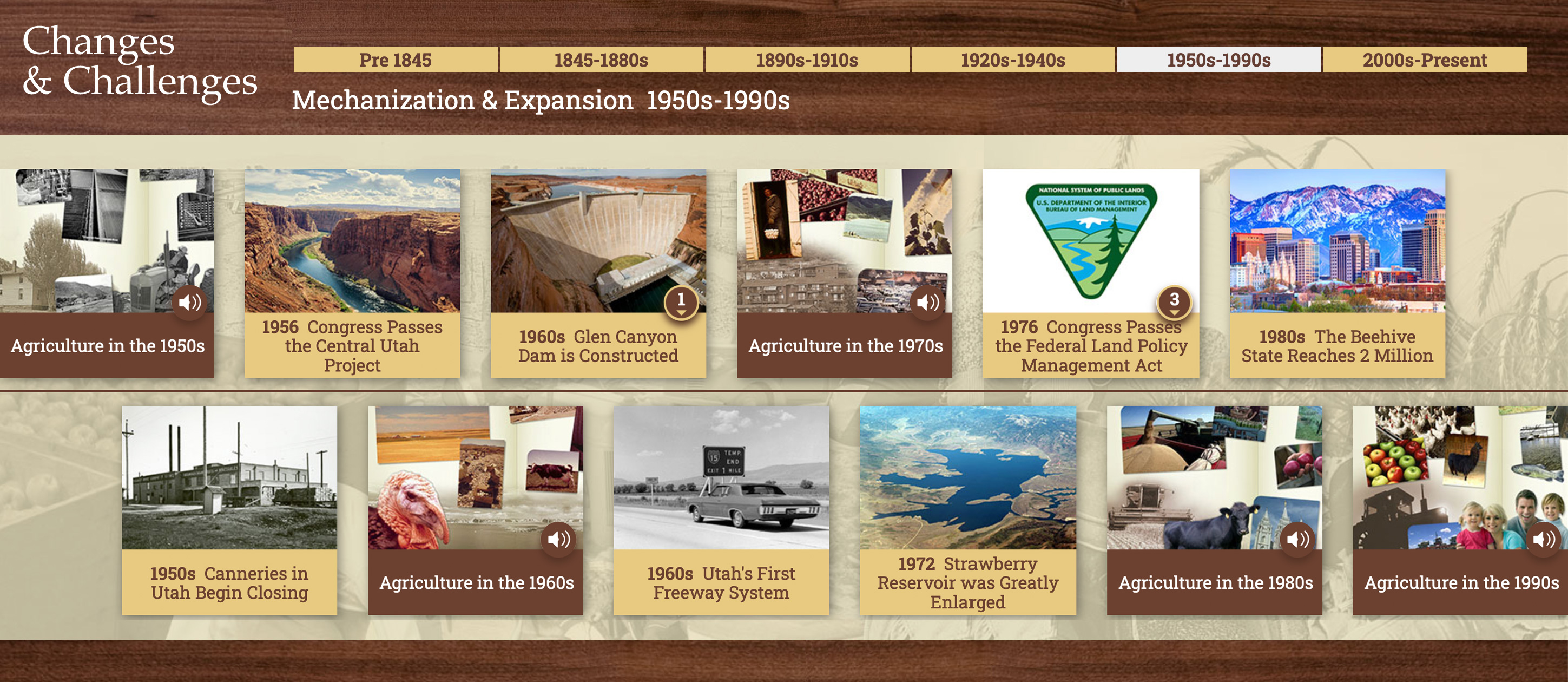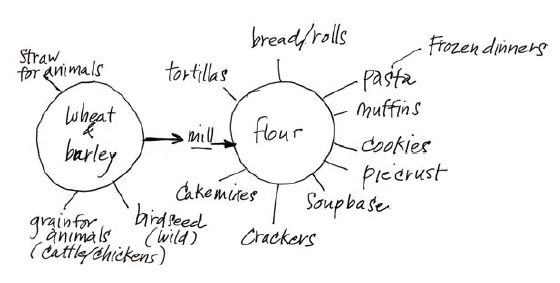Utah Studies
Changes & Challenges (1990s): Products of Utah Travel Worldwide

Grade Level(s)
6 - 8
Purpose
Students will develop an understanding of products grown and processed in the state of Utah while learning about supply chains, geography, and agriculture.
Estimated Time
45 minutes
Materials Needed
- Changes and Challenges Interactive Timeline
- Utah Agriculture Activity Map, 1 per student
- Utah Railroads Map
- Utah Highway Map
- Crayons
- List of Agricultural Processing Businesses in Utah
Essential Files (maps, charts, pictures, or documents)
Vocabulary Words
- supply chain: system of organizations, people, activities, information, and resources involved in moving a product or service from supplier to customer
- food processing: the process of transforming raw agricultural products, like grains, vegetables, meat, or milk, into end products to be sold to consumers
Background Agricultural Connections
About 17% of Utahns are employed directly or indirectly by agriculture. A grocer in Ogden needs someone to deliver tortillas made in Salt Lake City, and a tortilla-maker depends on a miller in Logan to grind wheat into flour; the miller relies on a wheat producer in Salina to grow the grain, and ultimately each person is hoping that Utah consumers purchase their "homegrown" tortillas in the store. It can be a complicated process to produce our food locally, but it provides essential jobs and income. Products grown and processed in Utah have always been an important part of our state's economy. Driving the Golden Spike was only the beginning for sending Utah products from Salt Lake City to Singapore and beyond.
Historians agree that the driving of a golden spike at Promontory Summit, Utah on May 10, 1869 was one of the most important events in United States history. It was also a pivotal point in Utah history; railroads enabled Utah to become the "Crossroads of the West," a place for agricultural goods to be processed and shipped throughout the West.
Utah was one of the few places in the West that had railroads running in all directions of the compass. Union Pacific lines ran west from Evanston, Wyoming down Weber Canyon to Ogden. The Oregon Short Lines had routes between Salt Lake City and Ogden and north through Idaho. The lines operated by Union Pacific south and west of Salt Lake City went all the way to Los Angeles. And the Denver and Rio Grande Western Railway completed its narrow gauge line between Colorado and Salt Lake City in March 1883.
Utahns saw the railroads more as a benefit to the communities they served than as profit-making enterprises. These "Mormon Roads," as some historians have called them, radiated like spokes of a wheel from Salt Lake City and Ogden. The Mormon Roads made the movement of goods and people easier within the territory.
Agricultural industries benefited greatly from a network of agricultural branch lines. Railroads played an important role in many supply chains, carrying dairy products, wheat, sugar beets, and all kinds of fruits and vegetables. Most of the vegetables and some of the fruits were grown as a part of the state's canning industry, centered mostly in Weber, Davis, and other counties along the Wasatch Front. Most of the dairy products and wheat were shipped to California. The destination for finished or refined sugar from sugar beets was local or other points in the middle and northwestern states. Utah's canned goods were sold mostly on the Pacific Coast and in the Intermountain West and Midwest.
The canning industry in the state placed Utah as the fifth ranked producer of canned goods in the nation in 1914. Of the more than seventy-five canning companies that were in business in the state, less than fifteen were truly successful and able to remain in business year-round. Each of these successful canning factories were located on a direct railroad connection.
Today, the food processing industry continues to be a vital part of Utah's agriculture and economy. Even now, the railroads play a large part in transporting goods and services from our communities to the processing facilities. From those facilities, Utah products are shipped not just to the Pacific Coast, but throughout the world, using all forms of transportation.
Agriculture in the 1990s, Narrative
By 1990 only 13 percent of Utahns lived in rural areas and the number of farms declined to 13,200. The average farm size fell to 856 acres. There were 11.3 million acres of farmland in Utah. Cattle and milk were once again the most important of Utah's agricultural products in this decade. Other important livestock products were poultry and eggs, along with an important increase in pork products. Hay and wheat continued to be the state's most valuable crops. Vegetables, particularly Spanish onions, as well as fruits such as apples and cherries remained very important. By the late 1990s many Utah farmers began to realize the growing population of the state was bringing a market for their products to their doorsteps. The 1990s again saw farmers searching, in the great tradition of Utah agriculture, for new commercial products. Some farmers began to experiment with ostrich and llama ranching while others tried fish farming. The year 2000 ended a century of change and challenge for Utah farmers.
Changes & Challenges Unit
This lesson is one in a series of lessons designed to accompany the Utah Studies course taught throughout Utah. The unit explores the settlement of Utah, the self-sufficient nature of the state's people, and the future of Utah agriculture and agricultural land. The Changes and Challenges Interactive Timeline accompanies the following lessons:
- Changes & Challenges (1840s-1880s): Era of Self-Sufficiency
- Changes & Challenges (1890s): Utah Becomes a State
- Changes & Challenges (1900s): Boom Time for Agriculture
- Changes & Challenges (1910s): The Boom Continues
- Changes & Challenges (1920s-1930s): Agricultural Hard Times and The Great Depression
- Changes & Challenges (1940s): World War II and Revival
- Changes & Challenges (1950s): Mechanization and Science
- Changes & Challenges (1960s-1970s): Expansion and Prosperity, Big Farms, Big Government
- Changes & Challenges (1980s): Recession, Expansion, and Utah Wheat
- Changes & Challenges (1990s): Products of Utah Travel Worldwide
- Changes & Challenges (2000s): Recession and Expansion
Interest Approach – Engagement
- On the Changes and Challenges Interactive Timeline, allow your students to listen to the narrative on the tile captioned, "Agriculture in the 1990s."
- As a class, discuss the top commodities and products produced in Utah during the 1990s.
- Pass out a Utah Agriculture Activity Map to each student. Ask students the following questions:
- Why do you think Utah's major agricultural products have changed over the last 100 years?
- What do you think the future is for Utah agriculture? (Ask students to consider population growth, water availability, land, etc.)
- Explain to students that another key component to agriculture and food production in Utah is transportation.
Procedures
- Give each student a copy of the Utah Agriculture Activity Map and the Utah Railroads Map.
- Display the Utah Highway Map so that it can be viewed by the students periodically throughout the activity.
- Looking at the Utah Agriculture Activity Map, have the students identify their local county and color it with a crayon.
- As a class, determine which agricultural commodities (or raw products) are produced in the local county using the legend. Are there any other counties that produce similar products? Can they identify the county seat for those areas?
- Have the students examine the Utah Railroads Map. Have them circle the state capital (Salt Lake City) and fill in the directions on the compass. Using the internet, have them determine the distance from their local city (or school) to the state capital.
- Review the background information with the students. Explain the importance of railroads to the early settlers of Utah. You may want to ask how often students see railroads in use today. Can they guess what might be on those trains?
- Have the students examine the maps of Utah highways and railroads. What similarities do they notice between these two maps? Point out to the students that the majority of our population resides in the areas where railroads were built. Students will generally recognize that the largest freeway system (I-15) also runs nearly parallel in most areas with the historical shipping lines.
- Ask the students to identify areas which do not contain any railroad systems. Why are these areas devoid of extensive transportation systems? Students will need to review the Utah highway map to see large geographical boundaries (Glen Canyon or Lake Powell, Uintah Mountains, LaSal Mountains, West Desert, etc.) Students may choose to mark these areas with their crayons on the railroad map with legend symbols.
- As a class and using the commodities from your county, brainstorm which processed foods could be developed from your locally produced agricultural products (see diagram below).
- Relate to the students that early settlers relied solely upon the railroad to transport raw products from farms to processing facilities. The further the distance to the processor, the more it would have cost a farmer to produce a product and the less money the farmer would be able to take home. This principle still applies today, although most farmers have more options in transportation. Using the List of Agricultural Processing Businesses in Utah and the Utah Railroads Map, have the students determine a historical estimated mileage to the closest processing facility if they were to make some of the products previously determined in the brainstorming session.
- Ask the students the following conclusion questions:
- Why did so many people stay and farm along the Wasatch Front? (Access to the railroad hubs, good climate and soils)
- Would it be difficult to be profitable in your local area based on access to transportation?
- How does purchasing locally grown/processed food help your local economy? (More jobs, fresher produce, less traffic and air pollution)

Concept Elaboration and Evaluation
After conducting these activities, review and summarize the following key concepts:
- Agriculture plays an important role in local, national, and global economies.
- Agriculture depends on integrated transportation networks to move raw products from farm to processor to consumer.
- Railroads played an important role in the agricultural and economic development of Utah.
Suggested Companion Resources
- Changes and Challenges (Activity): The Cox and Gossner Family Histories (Activity)
- 40 Maps that Explain Food in America (Poster, Map, Infographic)
- Utah Agriculture Activity Map (Poster, Map, Infographic)
- Ag Census Web Maps (Website)
Author(s)
Debra Spielmaker
Organization Affiliation
Utah Agriculture in the Classroom
-
Investigate the past and present role of agriculture in Utah. Meeting one or more of the following indicators:
- Identify the importance of farming and ranching to Utah's economy.
- Explain the impact the Great Depression on farmers and agriculture.
- investigate how agriculture has diversified and improved over time.
- Examine the cultural legacy of agriculture in Utah.
-
Investigate the relationship between physical geography and Utah's settlement, land use, and economy. Meeting one or more of the following indicators:
- Read and interpret a variety of maps.
- Identify the physical features and regions of Utah.
- Compare and contrast the relationship between physical features and regions to settlement, land use, and the economy.
-
Assess how natural resources sustain and enhance people's lives. Meeting one or more of the following indicators:
- Recognize the impact of water, minerals, wildlife, and forests on people.
- Distinguish between renewable and non-renewable resources.
- Analyze how natural resources improve the quality of life.
- Assess the importance of protecting and preserving natural resources.
-
Examine how people affect the geography of Utah. Meeting one or more of the following indicators:
- Identify Utah's counties and cities.
- Assess how people change the landscape.
- Examine how altered landscapes affect people.


